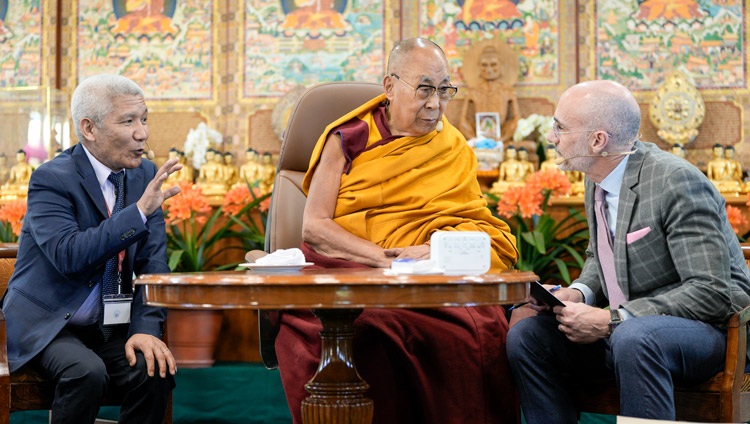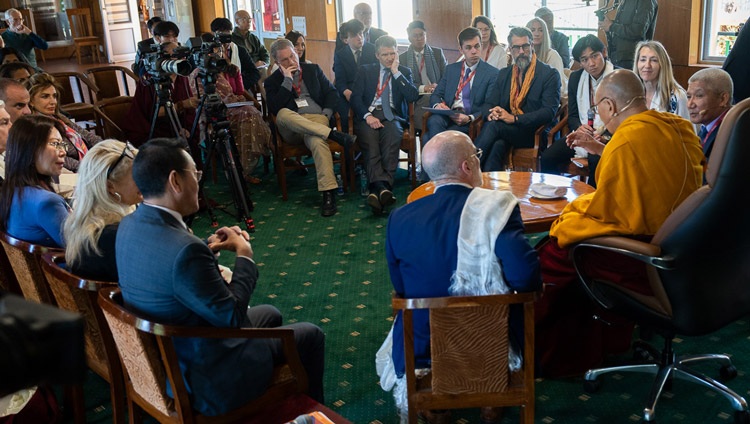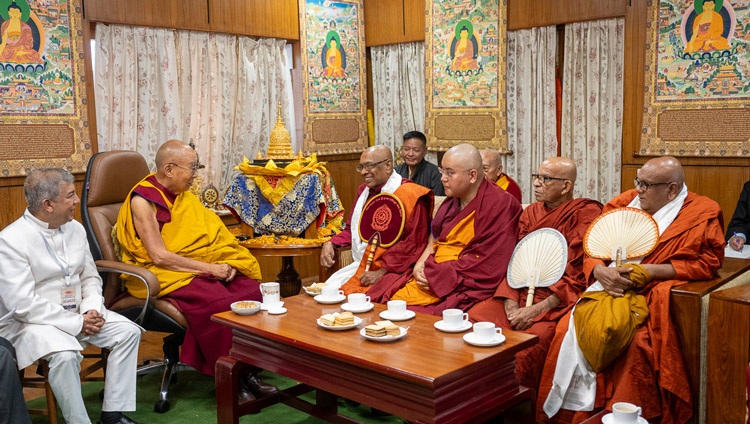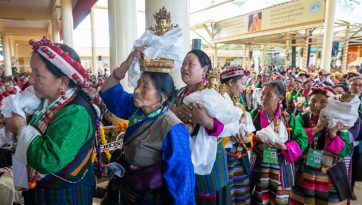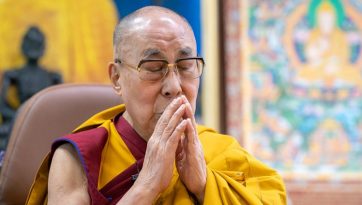The Heart Sutra – First Day
January 5, 2021
Thekchen Chöling, Dharamsala, HP, India – After His Holiness the Dalai Lama had arrived before the video cameras and taken his seat this morning, Korean Abbot Ven. JinOk welcomed him and reiterated the Korean disciples’ request that he explain the ‘Heart Sutra’ to them. Ven. JinOk then proceeded to recite the Sutra to the beat of the ‘moktak’ or wooden bell he held in his hands.
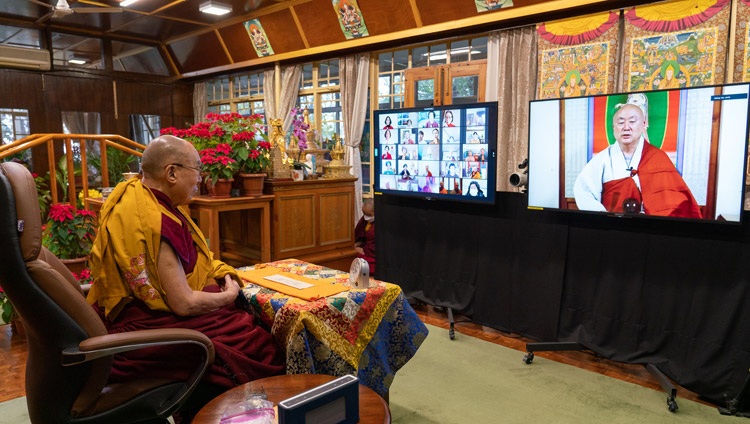
“Today, we are beginning three days of teachings for a group of Dharma brothers and sisters from Korea.” His Holiness announced. “I feel very fortunate to have this opportunity. There are Perfection of Wisdom sutras in 100,000 lines, 25,000 lines and 8,000 lines, while the shortest version consists of the letter ‘A’. The ‘Heart Sutra’ is referred to as the ‘Perfection of Wisdom in 25 Lines’, and despite its relative brevity, it is a comprehensive text.
“The Perfection of Wisdom teachings cannot be followed merely on the basis of faith. These are the kind of teachings that those of sharp intelligence follow on the basis of reason. The word wisdom in the name of these teachings shows that to understand them requires intelligence and the exercise of our analytical faculty. As the Buddha advised his followers, ‘O monks and scholars, as gold is tested by burning, cutting and rubbing, examine my words thoroughly and accept them only then — not just out of respect for me.’
“Those who taught and studied at Nalanda University relied on reason and logic.
“The Perfection of Wisdom teachings entail two aspects — the explicit explanation of emptiness and the implicit indication of how to make progress on the path. This second aspect, progress on the path, is represented in the ‘Heart Sutra’ by the mantra at the end. Since there are three vehicles, the Hearers’, the Solitary Buddhas’ and the Bodhisattvas’ vehicles, there are fifteen paths, five in each. How to make progress on the path is explained in the ‘Ornament for Clear Realization’.
“You have to listen to the teaching to gain a preliminary understanding, then reflect and think about it to deepen your understanding, finally meditating on what you’ve understood to develop experience of it.
“The ‘Heart Sutra’ presents the fourfold emptiness — ‘Form is emptiness, emptiness is form, emptiness is not other than form, form too is not other than emptiness’. Emptiness here doesn’t imply nothingness like the vacancy of space. When we examine how things exist, we find that it isn’t the way they appear. Emptiness isn’t about nothingness; it indicates that things depend on other factors. They lack independent, intrinsic existence in and of themselves.
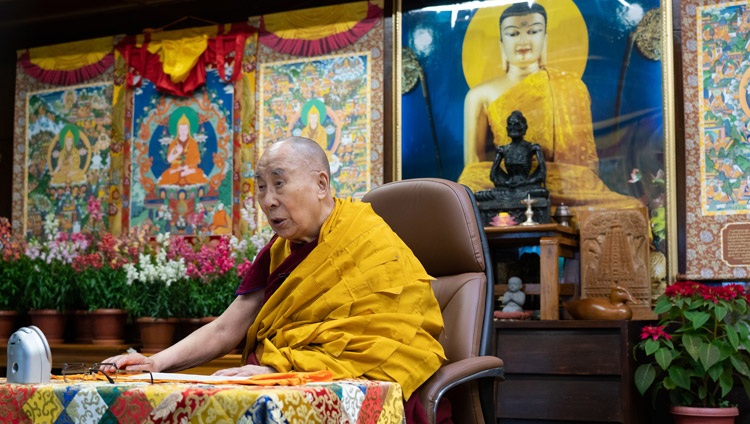
“We develop attachment to things based on seeing them as having intrinsic, objective existence — which is how they appear to exist. Nagarjuna is clear about this.
That which is dependent origination
Is explained to be emptiness.
That, being a dependent designation,
Is itself the middle way.
There does not exist anything
That is not dependently arisen.
Therefore, there does not exist anything
That is not empty.
“Destructive emotions are rooted in our having an exaggerated outlook on how things exist, which in turn prompts us to create all sorts of problems. Nagarjuna’s disciple Aryadeva also sheds light on this.
As the tactile sense [pervades] the body
Ignorance is present in all [afflictive emotions].
By overcoming ignorance, you will also
Overcome all afflictive emotions.
“What this means is that although there are specific ways to counter anger and attachment, by coming to understand emptiness and dependent arising, it is possible to root out all destructive emotions. Reflecting on how things do not exist objectively helps counter clinging to them as they appear.”
His Holiness pointed out that ‘Ornament for Clear Realization’ states that bodhichitta is that mind that wishes to attain enlightenment for the benefit of all beings. He suggested that it’s very helpful to combine it with a profound understanding of emptiness that is clearly explained in Nagarjuna’s ‘Fundamental Wisdom of the Middle Way’.
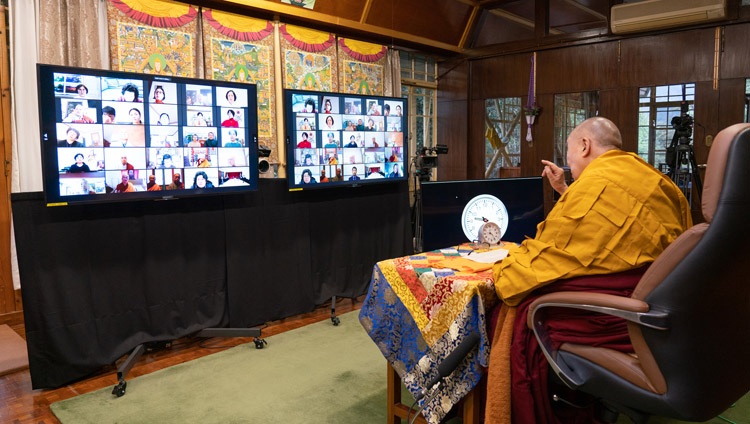
Turning to the ‘Heart Sutra’, His Holiness read the title in Sanskrit and Tibetan and clarified its meaning as ‘Heart of the Perfection of Wisdom’. The preamble indicates where the teaching was given, by whom and who were the recipients. After his enlightenment, the Buddha’s first round of teachings included not only the Four Noble Truths, but also Higher Knowledge (Abhidharma) and Monastic Discipline (Vinaya).
The causes of suffering referred to in the Four Noble Truths are karma and mental afflictions. To defeat them it’s necessary to overcome ignorance.
The Buddha’s teachings began with the Four Noble Truths, but later on Vultures’ Peak at Rajgir, receptive disciples heard him teach the Perfection of Wisdom. The latter two Noble Truths, true cessation and the true path, can only be fully understood in the context of the Perfection of Wisdom, which requires powerful intelligence.
His Holiness pointed out that only people with pure karma would have been aware of Avalokiteshvara’s presence and engagement in dialogue with Shariputra. The Buddha, meanwhile, had entered into a ‘meditative absorption on the varieties of phenomena called the appearance of the profound’. The sutra states that Avalokiteshvara saw that ‘even the five aggregates are empty of intrinsic existence’.
The word ‘even’ is not included in the Chinese translation of the sutra, and so, probably is not in the Korean translation either. It signifies that not only is the person designated on the basis of the five aggregates without intrinsic existence, but the aggregates lack intrinsic existence too. Although we say that things are empty, we cling to the five aggregates as if they were intrinsically existent.
His Holiness read the second and third paragraphs of the sutra. He noted that here form is the subject on the basis of which emptiness is explained because most of our judgements related to external phenomena depend on our sense of sight.
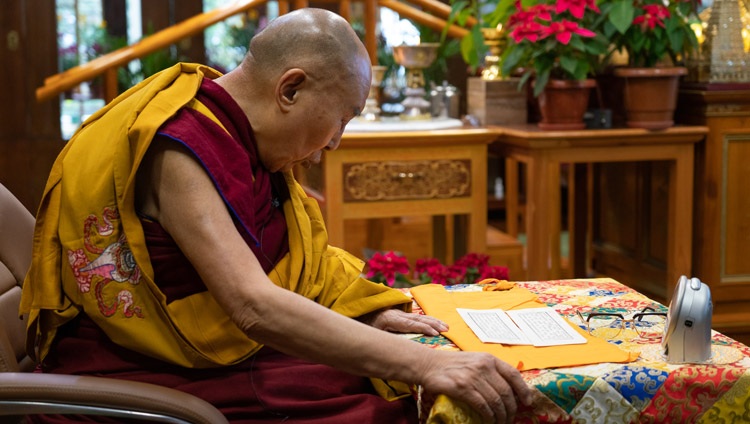
All things arise in dependence on other factors; therefore, they are empty. Form and emptiness are of the same nature, but are conceptually different.
His Holiness alluded to four logical fallacies that, in his ‘Entering into the Middle Way’, Chandrakirti explains would ensue if things had objective existence. They are that the Arya being’s meditative absorption on emptiness would be the destroyer of phenomena; that it would be wrong to teach that things lack ultimate existence; that the conventional existence of things would be able to withstand ultimate analysis into the nature of things, and that it would be untenable to state that things are empty in and of themselves.
“These four logical fallacies or absurdities are also mentioned in Jé Rinpoché’s ‘Essence of True Eloquence’ and the special insight section of the ‘Great Treatise on the Stages of the Path’.
His Holiness mentioned that while wisdom counters the notion of an intrinsically existent self, great compassion counters our extreme self-cherishing attitudes. He had particular praise for the powerful practice of exchanging self and others highlighted in Shantideva’s ‘Entering into the Way of a Bodhisattva’. This is a book he has studied and reflected closely on since he received an explanation of it from Khunu Lama Rinpoché. He made clear that this and Chandrakirti’s ‘Entering into the Middle Way’ are books he personally relies on. He added that Dignaga’s and Dharmakirti’s works on logic and reason have been key to developing a reasoned approach to Buddhism appropriate to the twenty-first century.
As he answered questions from monks and nuns from three temples in Korea His Holiness conceded that science and Buddhism have different goals — Buddhism is concerned with the mind and emotions, whereas science is more focussed on material things. However, since recognizing that our state of mind has a bearing on our health and well-being, science has begun to pay attention to Buddhist means for cultivating peace of mind.
His Holiness declared that the root of happiness is love and compassion, which we first experience in relation to our mother and which has nothing to do with religious practice. He is confident that the benefits of love and compassion can be presented from a secular point of view. After all, we are social animals concerned to protect the community in which we live. Recalling the oneness of humanity is a key part of Buddhism’s reasoned approach to the practice of love and compassion.
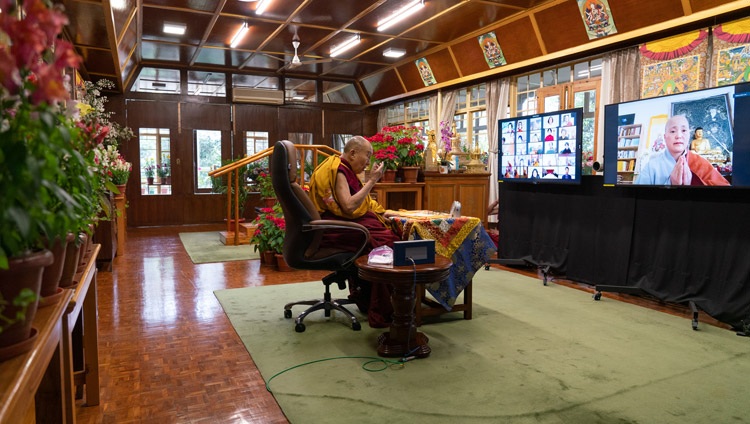
Asked how to resist negative feelings, His Holiness admitted that it is one thing to try to counter attachment, anger and hatred when they are strongly manifest. However, such feelings and emotions are harder to tackle when they are dormant. Nevertheless, cultivating loving kindness and the awakening mind of bodhichitta can help us reduce them.
With regard to the accumulation of virtue and wisdom, His Holiness drew a distinction between the physical and wisdom aspects of a Buddha. The physical aspect of the Buddha, which results from the accumulation of virtue, is a means for being of help to others. In addition, the more merit you collect, the better your understanding of emptiness will be. And as your understanding of emptiness improves, the clearer will be your recognition that achieving Buddhahood is a real possibility. Thus, merit and wisdom complement each other.
His Holiness read the fourth, fifth and sixth paragraphs of the ‘Heart Sutra’ before announcing that he would stop there for the day and resume his explanation tomorrow.
SOURCE: https://www.dalailama.com/news/2021/the-heart-sutra-first-day

